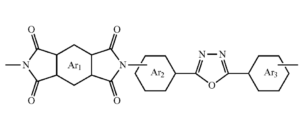10. Poly(imide-oxadiazole) Membranes for Gas Separation Applications
A gas separation membrane is provided. The gas separation membrane includes a poly(imide-oxadiazole) polymer including an oligomer having a structure comprising:
 In this structure, Ar1, Ar2, and Ar3 include aromatic moieties, and wherein Ar1, Ar2, and Ar3 are each independently selected.
In this structure, Ar1, Ar2, and Ar3 include aromatic moieties, and wherein Ar1, Ar2, and Ar3 are each independently selected.
Hayek, A.; Alsamah, A. US Patent Application (2022). US17/148,751.
9. Compositions of and Methods for Producing Modified Monomers and Polyimides for Sour Mixed Gas Separation
Compositions of and methods for producing a modified polyimide-containing compound with an alkyl or acyl group, one method including selecting and preparing a polyimide-containing compound to undergo a Friedel-Crafts alkylation or acylation reaction; carrying out the Friedel-Crafts alkylation or acylation reaction on the polyimide-containing compound to bond an alkyl group or acyl group to a reactive site on an aromatic compound of the polyimide-containing compound; cleaving the polyimide-containing compound to produce modified monomers comprising the alkyl group or the acyl group; and using the modified monomers in a reaction to produce the modified polyimide-containing compound, wherein the alkyl group or the acyl group is present in the modified polyimide-containing compound.
Hayek, A. US Patent Application (2021). US16/837,257.
8. Aromatic co-polyimide gas separation membranes derived from 6FDA-DAM-type homo-polyimides
Co-polyimide membranes for separating components of sour natural gas including at least three distinct moieties polymerized together, the moieties including a 2,2′-bis(3,4-dicarboxyphenyl)hexafluoropropane dianhydride (6FDA) based moiety; a 2,4,6-trimethyl-m-phenylenediamine (DAM) based moiety; and at least one component selected from the group consisting of: a 4,4′-(hexafluoroisopropylidene)dianiline (6FpDA) based moiety; a 9,9-bis(4-aminophenyl) fluorene (CARDO) based moiety; a 2,3,5,6-tetramethyl-1,4-phenylenediamine (durene diamine) based moiety; a 2,2′-bis(trifluoromethyl)benzidine (ABL-21) based moiety; a 3,3′-dihydroxybenzidine based moiety; and a 3,3′-(hexafluoroisopropylidene)dianiline based moiety.
Yahaya, G.O.; Hayek, A.; Alsamah, A.; Bahamdan, A. US Patent Application (2020). US16/287,474.
7. Aromatic co-polyimide gas separation membranes derived from 6FDA-6FpDA-type homo-polyimides
Co-polyimide membranes for separating components of sour natural gas including at least three distinct moieties polymerized together, the moieties including a 2,2′-bis(3,4-dicarboxyphenyl)hexafluoropropane dianhydride (6FDA) based moiety; a 4,4′-(hexafluoroisopropylidene)dianiline (6FpDA) based moiety; and at least one component selected from the group consisting of: a 9,9-bis(4-aminophenyl) fluorene (CARDO) based moiety; a 2,3,5,6-tetramethyl-1,4-phenylenediamine (durene diamine) based moiety; a 2,2′-bis(trifluoromethyl)benzidine (ABL-21) based moiety; a 3,3′-dihydroxybenzidine based moiety; and a 3,3′-(hexafluoroisopropylidene)dianiline based moiety.
Yahaya, G.O.; Hayek, A.; Alsamah, A.; Bahamdan, A. US Patent Application (2020). US16/287,467.
6. Cellulose Materials Bearing Amino Modifiers.
A molecule possessing a primary or secondary amino group and an additional functionality capable of providing a novel or improved property to a cellulose material has been permanently attached to the cellulose material in aqueous media using a water-soluble carbodiimide as the coupling agent/activator. One such molecule is 5-aminofluorescein (abbreviated as “A-fluo”) and one such cellulose material is a papermaking pulp. Papers made from a pulp furnish containing, for example, 0.01 wt. % of the “A-fluo”-attached pulp show an embedded marker feature authenticable upon UV or visible light excitation. The “A-fluo”-attached pulp can also be used for the marking and identification of a pulp furnish.
Hu, T. Q.; Hayek, A. United States Patent (2014), US 8,871,922 B2
5. Composite of Hydrophobic Lignocellulose Material Bonded to Complementary Material.
A method is conceived for producing hydrophobic lignocellulosics based on the graft copolymerisation of vinyl-type monomers onto the lignocellulosic backbone initiated by a redox couple initiator in aqueous medium. The green modification process can be carried out on any lignocellulosic material, for example, chemical, chemi-thermomechanical or thermo-mechanical pulps, bleached or unbleached. The technology disclosed in this invention yields individual lignocellulosic entities, for instance, hydrophobic pulp fibers, that can be used in combination with other fibers or polymers to produce nonwoven fibrous materials or composites. A significant aspect of the invention is that the modified lignocellulosic materialpossesses an efficient hydrophobic barrier and minimum interfacial energy to generate optimum adhesion when introduced to polymer resins. Hydrophobiclignocellulosics can have wide applications in products requiring high dimensional stability and excellent adhesion as in fiber-based packaging, decorative laminates, furniture and non-structural biocomposites.
Hamad, W. Y.; Hayek, A. United States Patent (2014), US 8,679,292 B2.
4. Variable Transmittance Optical Filter and Uses Thereof.
Variable transmittance optical filters capable of transitioning from a light state to a dark state on exposure to UV radiation and from a dark state to a light state with application of an electric voltage are provided. The optical filters comprise a switching material that comprises one or more chromophores that have electrochromic and photochromic properties.
Branda, N. R.; Lam, D.; Finden, J. G.; Hayek, A.; Hope-Ross, K. A.; Spantulescu, A.; Sviridov, S.; United States Patent (2014), US 8,687,258 B2.
3. Photochromic and Electrochromic Diarylcyclopentene Derivatives as Optical Filters.
A compound according to Formula IA and IB, reversibly convertible under photochromic and electrochromic conditions between a ring-open isomer A and a ring-closed isomer B is provided. For substitutent groups, Z is N, O or S; each R1 is independently selected from the group consisting of H, or halo; each R2 is independently selected from the group consisting of H, halo, a polymer backbone, alkyl or aryl; or, when both R2 together form —CH═CH— and form part of a polymer backbone; each R3 is independently selected from the group consisting of H, halo, alkyl, alkoxy, thioalkyl or aryl; each R4 is aryl; and each R5 is independently selected from the group consisting of H, halo, alkyl, alkoxy, thioalkyl or aryl.
Branda, N. R.; Finden, J. G.; Gauthier, S. J.; Hayek, A.; Hope-Ross, K. A.; Senior, J. D.; Spantulescu, A.; Sviridov, S.; United States Patent (2016) US 9,227,986 B2.
2. Silole-Based Monomers and Polymers for Organic Light-Emitting Diode Devices.
This invention relates generally to organic electroluminescent norbornene-silole monomer, poly(norbornene) homopolymer, and poly(norbornene) copolymer compounds, containing functionalized aryl and alkyl silole side chains having good host characteristics and solution processability, and to an electron transporting and/or hole blocking layers, and light-emitting layers, organic electronic devicesand compositions of matter, which include these compounds.
Hayek, A.; Zhan, X.; Marder, S. R.; Kippelen, B.; Domercq, B.; Haldi, A. PCT Int. Appl. United States Patent Application (2010), US 2010/0298590 A1.
1. Photochromic/Thermochromic Transitioning Chromophores and Formulations.
No details.
Branda, N. R.; Hayek, A.; Finden, J. G. U.S. Provisional Patent Application, U.S. Patent and Trademark Office. filed (2012).
